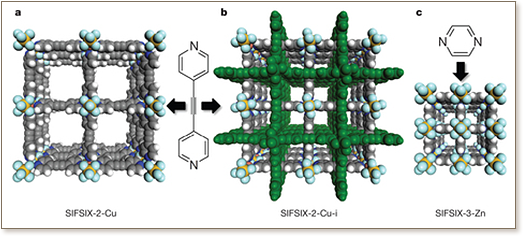

 The energy costs associated with the separation and purification of industrial commodities, such as gases, fine chemicals and fresh water, currently represent around 15 per cent of global energy production, and the demand for such commodities is projected to triple by 2050 (ref. 1). The challenge of developing effective separation and purification technologies that have much smaller energy footprints is greater for carbon dioxide (CO2) than for other gases; in addition to its involvement in climate change, CO2 is an impurity in natural gas, biogas (natural gas produced from biomass), syngas (CO/H2, the main source of hydrogen in refineries) and many other gas streams. In the context of porous crystalline materials that can exploit both equilibrium and kinetic selectivity, size selectivity and targeted molecular recognition are attractive characteristics for CO2 separation and capture, as exemplified by zeolites 5A and 13X (ref. 2), as well as metal–organic materials (MOMs)3, 4, 5, 6, 7, 8, 9. Here we report that a crystal engineering7 or reticular chemistry5, 9 strategy that controls pore functionality and size in a series of MOMs with coordinately saturated metal centres and periodically arrayed hexafluorosilicate (SiF62−) anions enables a ‘sweet spot’ of kinetics and thermodynamics that offers high volumetric uptake at low CO2 partial pressure (less than 0.15 bar). Most importantly, such MOMs offer an unprecedented CO2 sorption selectivity over N2, H2 and CH4, even in the presence of moisture. These MOMs are therefore relevant to CO2 separation in the context of post-combustion (flue gas, CO2/N2), pre-combustion (shifted synthesis gas stream, CO2/H2) and natural gas upgrading (natural gas clean-up, CO2/CH4).
The energy costs associated with the separation and purification of industrial commodities, such as gases, fine chemicals and fresh water, currently represent around 15 per cent of global energy production, and the demand for such commodities is projected to triple by 2050 (ref. 1). The challenge of developing effective separation and purification technologies that have much smaller energy footprints is greater for carbon dioxide (CO2) than for other gases; in addition to its involvement in climate change, CO2 is an impurity in natural gas, biogas (natural gas produced from biomass), syngas (CO/H2, the main source of hydrogen in refineries) and many other gas streams. In the context of porous crystalline materials that can exploit both equilibrium and kinetic selectivity, size selectivity and targeted molecular recognition are attractive characteristics for CO2 separation and capture, as exemplified by zeolites 5A and 13X (ref. 2), as well as metal–organic materials (MOMs)3, 4, 5, 6, 7, 8, 9. Here we report that a crystal engineering7 or reticular chemistry5, 9 strategy that controls pore functionality and size in a series of MOMs with coordinately saturated metal centres and periodically arrayed hexafluorosilicate (SiF62−) anions enables a ‘sweet spot’ of kinetics and thermodynamics that offers high volumetric uptake at low CO2 partial pressure (less than 0.15 bar). Most importantly, such MOMs offer an unprecedented CO2 sorption selectivity over N2, H2 and CH4, even in the presence of moisture. These MOMs are therefore relevant to CO2 separation in the context of post-combustion (flue gas, CO2/N2), pre-combustion (shifted synthesis gas stream, CO2/H2) and natural gas upgrading (natural gas clean-up, CO2/CH4).